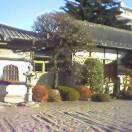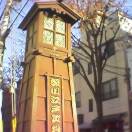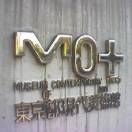         |
|||
 |
|||
|
m o r i s h i t a ... k i y o s u m i - s h i r a k a w a  Museums and Parks ---- On first impression Morishita (in Koto Ward, Tokyo) looks like a typical Tokyo wasteland -- all concrete apartment blocks and no soul (see the photo bar on the left.) However, poke around a little and you will find another world beneath the concrete towers -- an older world, an Edo world. Just like Nezu on the other side of the Sumida River, Morishita is home to some of the best preserved streets and historic temples and funky shops that I have seen in Tokyo. Close to other atmospheric attractions like Ryogoku and Monzennakacho, Morishita (and nearby Kiyosumi-Shirakawa) houses several noteable and noteworthy museums. If you are interested in history, the Edo Tokyo Museum (・ス]・スヒ難ソス・ス・ス・ス・ス・ス・ス・ス・ス) is for you. Dedicated to the Edo period of Tokyo's development, the museum boasts a reconstruction of the original Nihombashi bridge, a several meters-long miniature of the palace of Lord Matsudaira in Otemachi, and a scale model of the old Nihombashi neighbourhood. For miniature freaks, this place can't be beaten! Another museum of this very museum oriented suburb is the Matsuo Basho Museum. According to TokyoGuide.com: "The famous poet and haiku master Basho Matsuo (・スm・スヤ擾ソス・スj) lived here from 1680 to 1682, along by the Sumida River, between the Shin-Ohashi Bridge and Kiyosu Bridge. This museum is situated on the grounds of Basho's former hermitage ("Basho-an"). Several of Basho's most acclaimed haiku and travel journals such as "Okuno Hosomichi" were composed while he was staying at "Basho-an". The Museum keeps the collection of materials related to Basho. The museum is 7 minute walk from Morishita station (Address : 1-6-3 Tokiwa, Koto-ku)." South of Morishita is Kiyosumi-Shirakawa, one of the best places in Tokyo to find old shops, houses and temples. The largest number of Buddhist temples can be found in the Northern neighbourhoods of Miyoshi and Shirakawa. Most of them belong to the Jodo and Nichiren branches. Coming from Kiyoshumi-Shirakawa station, you will first come across the Edo Fukagawa Museum (・ス]・スヒ深・ス・托ソス・ス・ス・ス). Although small, it gives the visitor a good idea of how life was in Tokyo during the late Edo period (1600-1868). Admission is ・ス・ス300 for adults and ・ス・ス50 for children. One of the best streets in the general Morishita/Kiyosumi-Shirakawa area (in my opinion at least) is Fukagawa Shiryokan Dori. Fukugawa Shiryokan Dori meets the busy Kiyosumi Dori highway opposite Kiyosumi Gardens (・ス・ス・ス・ス・ス・), which are an attraction in themselves with a long and historic history. Fukagawa Shiryokan Dori is one of those streets in Tokyo where you can still find stands of traditional houses and colorful shops selling Buddhist goods. There are also plenty of temples on the sidestreets. While you are busy sightseeing in the area you can stop off at the new ・ス・ス100 Lawson convenience store on the steet to stock up on snacks and refreshments. Almost everything in the convenience store (actually more like a supermarket) is ・ス・ス100 (about one American dollar) -- add another ・ス・ス5 for the sales tax. The last time I was there I got a bacon and mayonnaise onigiri rice ball -- an interesting blend of Japanese tradition and American fast food biz, wrapped in seaweed. Very satisfying and cheap to boot! If you follow Fukagawa Shiryokan Dori from Kiyosumi Dori all the way to the end, you will pass the aforementioned Edo Fukagawa Museum, and the also aforementioned ・ス・ス100 Lawson store, and eventually you will spill out on to Mistume Dori. On first sights this looks like a rude and dreary road lined with faceless apartment blocks, but there are a few gems amongst all the banality. A short walk from the intersection with Fukagawa Shiryokan Dori, heading towards Kiba, lies the Tokyo Museum of Contemporary Art. It seems like an interesting building from the outside -- a postmodern blend of old Japan castle and futuristic glass. Beyond the museum, the vast Kiba Park retreats into the distance. But that's another story!
|
|||
|
tokyo japan 2005
copyright rob sullivan 1996-2005 and beyond!
| |||